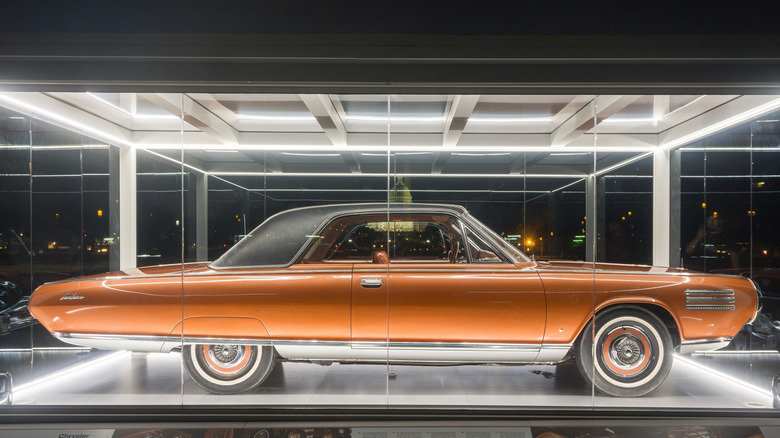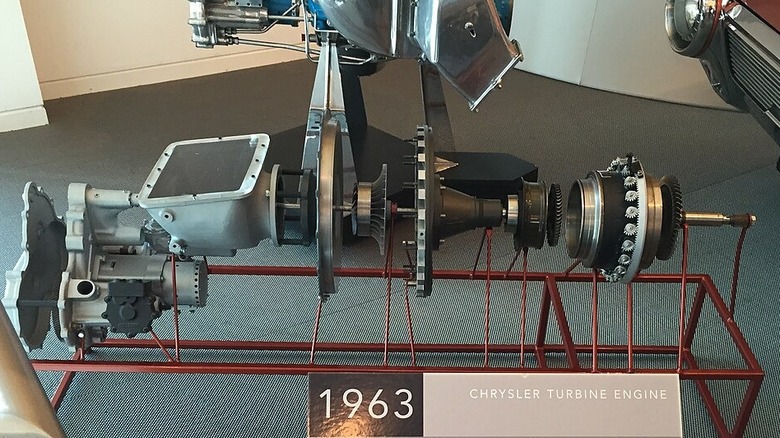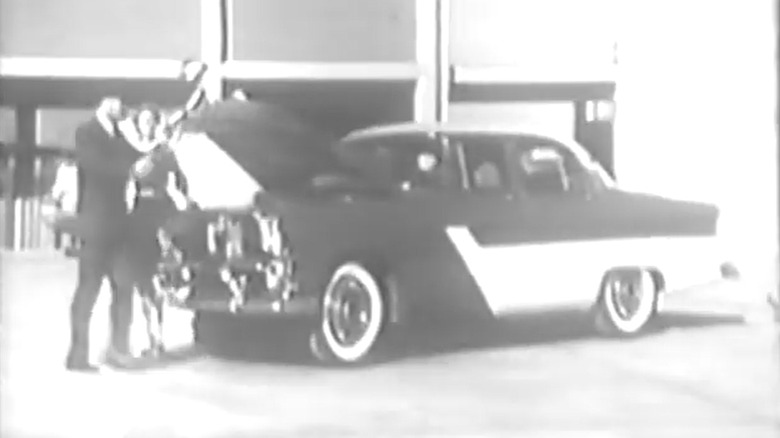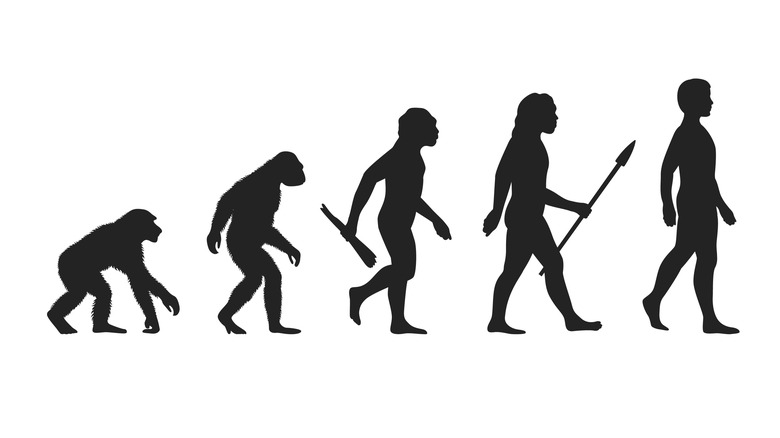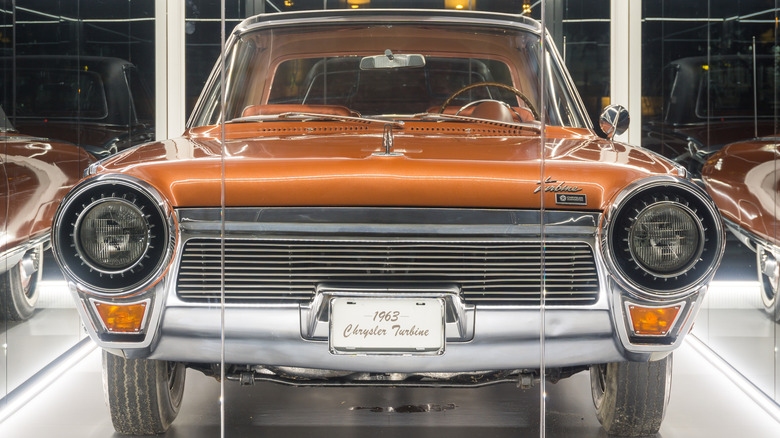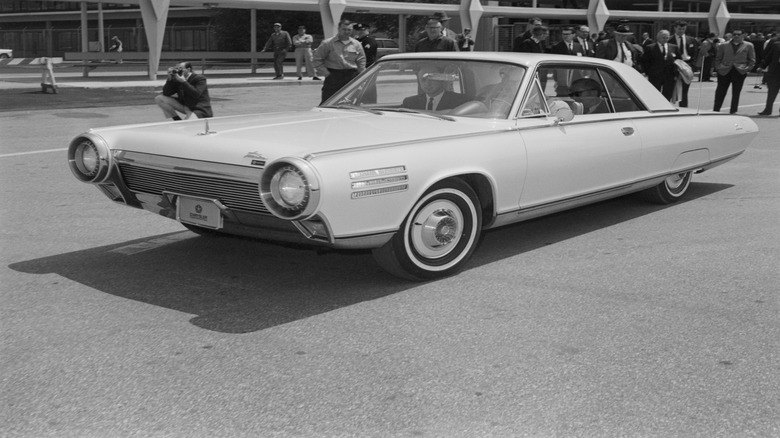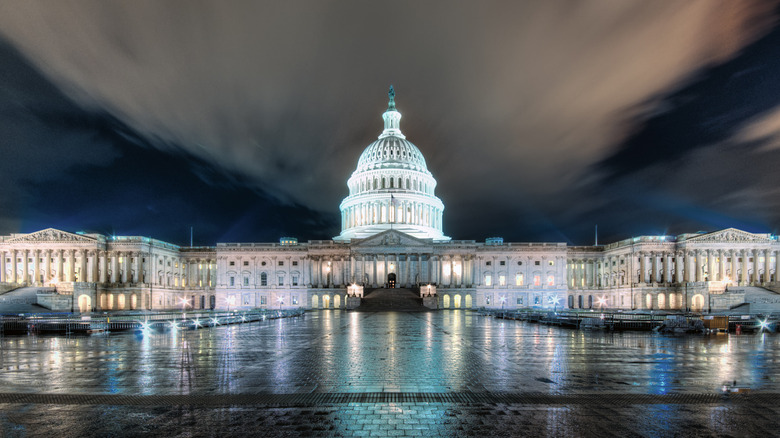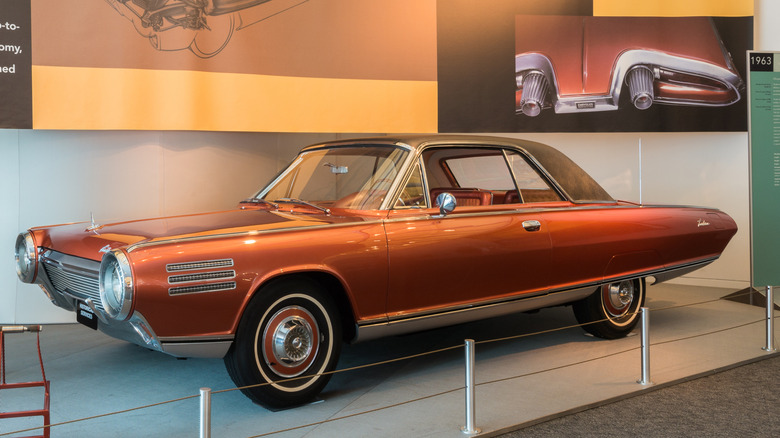History Of The Chrysler Turbine Engine (And What Makes It So Unique)
Give it wheels and a steering mechanism, and people will try to power it with anything they can. Visionary (and not-so-visionary) tinkerers and engineers have experimented with everything from steam to electricity to piston and rotary-powered engines in bids to bring better, more powerful, or more efficient power to the automotive sphere.
With the rise of the jet age and its attendant technologies near the end of World War II, even more possibilities emerged. Powerful, loud, and ravenous for fuel, a jet engine might seem an impractical propulsion unit for a car, but the Chrysler Corporation of the 1950s wasn't so sure.
Inspired by new technology emerging in the post-war years, Chrysler went out on a limb and spent big bucks developing a turbine-based powerplant for a road-going vehicle. Chrysler's turbine car may not have revolutionized the industry, but it has become a bona fide piece of automotive lore.
Join us as we delve into Chrysler's pursuit of revolution and explore the history of its ultra-rare turbine car.
Chrylser gets into the turbine business
In the fall of 1945, the Bureau of the Aeronautics of the U.S. Navy awarded Chrysler a contract to build a gas turbine engine for aircraft use. Chrysler developed what would become the A-86 turboprop engine, a cutting-edge technology at the time. However, when the government canceled its contract in 1949, Chrysler was left with an engine that had no purpose.
The new turbine technology held great promise, offering several advantages over piston-powered counterparts. Turbines' rotational operation ensured a smoother power delivery than vibrating piston engines.
With fewer moving parts, turbines were generally smaller and lighter. This was a significant shift from the dominance of piston engines in the automotive industry since the decline of electrically powered cars in the early 20th century.
It was not all roses, however. Turbines tend to be less efficient than piston engines. Their tolerances are smaller and less forgiving, requiring a specialized production process. Mass production would require a costly retooling of assembly lines. Besides, turbine jet engines push aircraft via rearward thrust, which is not permissible in traffic. Automobile turbines drive a second-stage blade through a gear reduction that slows the high rotations-per-minute and sends power to the drive wheels.
Chrysler engineers toyed with a pre-war concept of turbine-powered cars but shelved the idea. Materials technology was not up to the task. But with the millions poured into wartime technological development, that changed.
[Featured image by DRIVERofPontiacs via Wikimedia Commons | Cropped and scaled | CC BY-SA 4.0]
From aircraft to automobile
The engineers developing a turbine engine for auto application faced many problems. Shrieking operation and scorching exhaust might work at an airfield or in the sky, but not so much in the suburbs springing up nationwide in the post-war days.
The Chrysler Turbine debuted in 1963, but the automotive firm had a road-going vehicle with a turbine powerplant ready a decade prior. On March 25, 1954, Chrysler announced that it had successfully developed and road-tested a turbine-powered 1954 Plymouth coupe. It demonstrated its success at the Chrysler Engineering Proving Grounds opening in Chelsea, Michigan, on June 5 that same year.
Engineers solved the exhaust heat problem by introducing a heat exchanger, which brought the full-power temperature down to 500 degrees Fahrenheit from a whopping 1,200. At idle, the Plymouth put out only 170 degrees.
Chrysler ran with the concept. A 1956 Plymouth sedan underwent a trans-continental endurance trek from New York to Los Angeles. Appropriately enough, it departed from the Chrysler Building on March 26, 1956, and pulled up to City Hall in Los Angeles four days later. A few minor repairs were required along the way, but none related to the turbine, which claimed a 13 mpg fuel rating.
The cross-country test proved that the turbine could be a viable option for the future of automobiles, so Chrysler continued its development throughout the remainder of the 1950s.
Turbine evolution
The first-generation turbine produced 100 hp and three years after its cross-country test, a 1959 Plymouth equipped with the new engine underwent a 576-mile endurance test between Detroit and New York in December 1958. The results were promising. The latest setup bumped output to around 200 hp while improving compressor efficiency by 10% and reclaiming an additional 5% of heat energy from the exhaust.
The future of the turbine-powered automobile looked promising enough for Chrysler to continue investing in its development. By the early 1960s, a third-generation engine, the CR2A, appeared.
The CR2A gas turbine found a home in a specially designed Dodge Dart that departed on a cross-country shakedown on December 27, 1961. Enduring powerful headwinds, a trio of snowstorms, the high passes of the Rockies, and the endless plains of the Midwest, it arrived in Los Angeles on December 31, 1961, where a crew of delighted engineers inspected it.
Not only had the turbine achieved fuel efficiency superior to that of a piston engine, but it was also in excellent condition, showing few signs of wear. A new turbine nozzle design reduced the 7 second accelerator lag experienced by the first generation to less than 1.5 seconds.
Chrysler promptly installed the engine in a second Dart and a pair of Plymouth Furys. The quartet of Turbo Darts and Turbo Furys then traveled the country on a promotional tour, drumming up interest in what looked like a market-breaking innovation.
Going all in
Advances in jet and materials technology had an enormous impact on culture. The Soviet Union launched the first satellite in 1957, prompting the formation of NASA the following year. In 1959, Cadillac released one of the best-looking models it had ever designed, adorned with rocket inspired fins and taillights.
The 1960s were eagerly anticipated as the era of future technology, and Chrysler was ready to make a bold move. Each turbine-powered Chrysler had been experimental.
The fourth generation successor to the CR2 would go into a limited production vehicle called the Chrysler Turbine. Executives tapped styling director Elwood Engel to head up the project. Moving over from Ford, Engel took over the project from the departing Virgil Exner.
Chrysler brought in famed Italian bodywork firm Carozzeria Ghia to add its signature flair. The result was a design that was as smooth as the turbine engine that would drive it. It featured a friendly front end with round headlights and sleek lines tapering to an extended rear deck culminating by a rocket-inspired rear end that resembled a reimagined '59 Cadillac.
Each of the 55 experimental sedans got custom paint, now known as Turbine Bronze and an interior on the cutting edge of comfort and design. Chrysler set out to discover if the public would love the Turbine as much as its designers and engineers did.
The high water mark
The fourth-generation engine under the hood of the 1963 Chrysler Turbine represented another technological advancement. A pair of regenerators recycled exhaust heat, and the redesigned nozzles cut down on accelerator lag.
It made 130 hp and a genuinely bizarre 425 lb-ft of torque with a gasoline efficiency rating of 14 mpg city and 18 highway. Virtually anything combustible could serve as fuel without any modifications. Chrysler claimed it could run on anything from Chanel No. 5 to peanut oil.
Chrysler debuted the Turbine in New York City on May 14, 1963. It embarked on a world tour, visiting 23 cities across 21 countries, including places as far afield as Tokyo and Buenos Ares. The President of Mexico took one for a tequila-fueled (the car, not the President) spin. Headlines trumpeted the arrival of the future.
Over 30,000 people applied for the pilot program. Chrysler ultimately lent 50 Turbines to 203 families on three-month rotations, forbidding them from taking it out of the country and requiring feedback on their experience. The Turbine Car Evaluation Program would use its post-driven inspection of the engine and the feedback from drivers to inform its turbine program moving forward.
Turbine Car Evaluation Program
Chrysler would collect the final loaned Turbine in 1966, issuing its report on the program the following year. The report outlined some of the pros and cons of the effort.
On the bright side, the drivers enjoyed the Turbine's lack of maintenance, and Chrysler discovered that the engines were barely worn compared to piston engines. Consumers appreciated arguably the Turbine's greatest advantage — silky smooth power generation — in addition to the car's styling and comfort.
Despite all the hype and the improvements engineered by Chrysler, there were also significant drawbacks. Significant issues included a lack of natural engine braking that gave it an unnatural driving feel, high nitrogen oxide emissions, an operation better suited to cruising than stop-and-go driving, and an insanely high internal temperature of 2,000 degrees Fahrenheit.
A quarter of respondents lamented its gas mileage, which dropped to about 11 mpg over the lengthy test program. A third cited the accelerator lag as a major irritant. Unmentioned, yet surely in the backs of the minds at Chrysler, was the difficulty of supplanting piston engines. With the advantage of an incumbent, piston engines weren't about to go anywhere, and it remained to be seen if the pros of turbine power could muscle into the market.
Chrysler destroyed all but nine of the Turbines upon collecting the last loaner in 1966. The balance are in museums (and Jay Leno's garage), making them priceless pieces of automotive history today.
A dying dream
Chrysler had been developing the turbine engine well before anyone believed in it, and that wasn't about to stop. Even as the evaluation cars made the rounds, the company had a fifth generation called the A-875 in a testbed 1964 Plymouth. The sixth generation design was ready by 1966, too.
Chrysler was spooling up to build 500 turbine-powered Coronets for sale to the general public. There was also talk of the upcoming Dodge Charger being a turbine car. Unfortunately, one consistent sticking point would ultimately spell doom for the idea of commercially available turbine-driven automobiles.
At the height of the muscle car era, the government grew concerned over the impact gas-guzzling V8s had on the environment. This concern extended to Chrysler's turbine powerplant and its high nitrogen oxide emissions. The impending regulation and high mass production costs dampened enthusiasm for the turbine, but it didn't kill it outright.
In 1972, the Environmental Protection Agency issued Chrysler $6.4 million to continue development. The result was the seventh and final generation of the Chrysler turbine engine intended for use in cars. The engine was an improvement on previous iterations. It virtually eliminated throttle lag, reduced emissions to then-acceptable numbers, and improved fuel economy, but it wasn't enough. Like the earlier engines in the 1950s, only a handful of prototypes went into vehicles.
The final turbine cars
A pair of 1976 Dodge Aspens and a 1977 LeBaron-inspired concept got the turbine treatment. By 1979, the two Aspens ran well, but increasing crackdowns coupled with fuel supply crises had their impact. Despite a program that received funding from the United States Department of Energy, the days of the Chrysler turbine were numbered.
By the late 1970s, Chrysler was on the verge of bankruptcy, and experimental cars were not the way to financial resurrection. The final cars to receive a Chrysler Turbine were a '78 LeBaron and an '81 Dodge Mirada. Upon the end of the program, the U.S. government held onto both, and what started as a sci-fi thought experiment in the late 1930s slid beneath the surface of automotive history with a sigh 50 years later.
Chrysler didn't build the first-ever turbine car, but it might have built the most famous. Like Mazda and its rotary engines, Chrysler doesn't own the rights to turbines, but is closely associated with the engine type. The cultural and historical splash made by the 1963 Turbine endures.
All of that belief in the turbine engine didn't go for naught, either. Chrysler applied its research, knowledge, and experience to develop the turboshaft turbine engine for the prototype XM1 tank, which would grow into the one of the best tanks ever made, the M1 Abrams.
